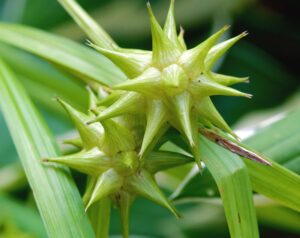Here are Ottawa’s most beautiful plants for butterflies

As an ecological landscaper, I work with beautiful native plants every day. Yet many of Ottawa’s most remarkable native species are unfamiliar to the public and underused in home gardens.
The five plants featured here stand out not only for their essential role in supporting wildlife, especially butterflies, but also for the visual interest they offer and specific design functions they serve.
Spotted Joe Pye Weed
Spotted Joe Pye weed (Eutrochium maculatum) is most remarkable for its height — up to two metres — and its enormous flowers. Each vanilla-scented flower is made up of many clusters of tiny pinkish-purple florets. Use its statuesque height strategically to add vertical structure and create a natural focal point. Its sturdy stems will remain upright well into winter, adding visual interest and welcoming birds to forage.
It is also one of the busiest flowers in my garden, frequently visited by many species of bees and butterflies, including monarch, swallowtail, and azure butterflies. While it naturally grows in moist environments, it is surprisingly adaptable and can thrive in dry or average soil and is drought tolerant. Plant in full to part sun conditions.
Rough blazing star
Rough blazing star (Liatris aspera) is another star in my garden. Grown from seed from the Ottawa Wildflower Seed Library, it took two years to see flowers. Yet those first flowers attracted black swallowtail and monarch butterflies for extended periods of time last summer. Out my kitchen window, I would watch up to four monarchs at a time drinking nectar from a cluster of rough blazing stars.
Blazing stars are not native to the Ottawa region and are found mainly in remnants of southern Ontario’s tallgrass prairies. I’ve included them to highlight their critical significance for monarch butterflies. Their late summer, long-lasting purple flowers provide nectar before migration. In addition, dense blazing star (L. spicata) is listed as a threatened species in Ontario.
All blazing stars are drought tolerant. Cylindrical blazing stars (L. cylindracea) stay under 60 cm, making them suited to dry, sunny boulevard gardens. Rough and dense blazing stars can grow to 1.5 metres, so plant them at the back of a border to take advantage of their showy, dramatic height. Plant them among a matrix of little bluestem grass to mimic their natural prairie habitat and keep them upright. Dense blazing star also suits rain gardens, as it thrives in both dry and moist soils.
Morning star sedge
One of Ottawa’s most unusual plants is the morning star sedge (Carex grayi). Its spiky, star-shaped seed heads add unique texture and bold shapes to summer gardens. It prefers part sun to part shade and moist to average soil.

Sedges as a group are an especially overlooked and underused genus in landscape design, especially for shady gardens. They are semi-evergreen, flower in spring, and can be used as a living mulch to create lush woodland gardens even in dry conditions.
Wild and Woodland Strawberry
Two beautiful and very effective native groundcovers are wild strawberry (Fragaria virginiana) and woodland strawberry (F. vesca). Similar to sedges, use these as a green mulch between larger plants, where they suppress weeds and create a soft, living carpet.
Wild strawberry thrives in sunny spots while woodland prefers shade. Both suit dry soil and have delicate white flowers and tiny, edible fruit — though birds and other wildlife will likely beat you to the harvest! Native strawberries are also a host plant for silver-bordered fritillary butterflies and dozens of moth species.
Cardinal flower
Cardinal flower (Lobelia cardinalis) is the most stunning plant I’ve ever grown. Its vivid red flowers stand out in any garden. It attracts swallowtail butterflies, but its primary pollinator is the ruby-throated hummingbird. It grows best in part sun to full shade with medium to moist soil.
To enjoy its dramatic, vibrant flowers and have the best chance of spotting hummingbirds, plant it in view of a window. Surround it with shorter species like golden Alexander, fox sedge, and blue flag iris.
I’ve chosen the cardinal flower as the logo for my new business, Cardinal Glen Ecological Landscaping. To me, it represents the striking and often unexpected beauty that native plants can bring to our landscapes.
Find these plants at my own micro-nursery or from A Cultivated Art, Trinkets & Thyme, Nursery for the Earth, Fletcher’s spring sale, or Ottawa Wildflower Seed Library giveaways.
Christina Keys is the owner of Cardinal Glen Ecological Landscaping, specializing in the design and installation of native plant gardens. She is a volunteer with the Manor Park Community Association Environmental Sustainability Committee and the Butterflyway Ranger for Manor Park and Cardinal Glen.


